Plant Baking Peak
The use of hot rocks to bake roots and bulbs appears to have reached an all-time high across the Edwards Plateau during the Late Prehistoric period between about 800-1400 A.D. Many of the heaped accumulations of discarded cooking stones (burned rocks) known as burned rock middens formed or grew during the Late Prehistoric plant baking peak. This pattern of resource use intensification began in the latter part of the Late Archaic, but appears to have peaked in the Late Prehistoric era across most of the Plateau. This can be seen by the widespread occurrence of Late Prehistoric middens in many places across the landscape where earlier, Archaic-period midden accumulations are absent or rare, particularly in the southern and western portion of the Edwards Plateau. Along the eastern edge of the Plateau and in the Lower Pecos canyonlands, plant baking may have peaked earlier, during the Late Archaic.
Until the 1990s conventional archeological wisdom held that central Texas burned rock middens primarily dated to the Middle and Late Archaic periods. The increased use of radiocarbon dating at many midden sites investigated over the last two decades tells a different story. Several hundred radiocarbon assays now have been run on samples from burned rock middens. Most midden assays yield calibrated date estimates that fall between A.D. 800-1400. There is little doubt that earlier dates are somewhat underrepresented because of preservation bias—older charcoal is less likely to be preserved, hence less likely to be sampled than later charcoal. Several research teams have made concerted efforts to date early periods of midden use. Plant baking and burned rock midden accumulation did begin in Early Archaic times, particularly along the eastern Edwards Plateau. And the pattern continued into the Middle and Late Archaic periods. But the peak and maximum geographical spread of plant baking and midden accumulation clearly dates to the Late Prehistoric period. Why?
The simple and most convincing explanation is that the Late Prehistoric peaks of plant baking and midden use are strongly tied to population pressure. The combined impact of more people, smaller territories, and more dietary stress, appears to have forced prehistoric groups to intensify the use of marginal resources—such as roots and bulbs. This interpretation can and should be tested by additional research and sampling in poorly known areas of the region. To learn more, read Population Pressure or visit the Camp Bowie Middens exhibit.

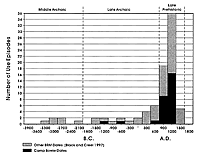
Radiocarbon date distribution of 87 burned rock midden use episodes from 40 sites on and near the Edwards Plateau, as judged from patterns seen among a total of 150 radiocarbon assays. This distribution clearly shows that plant baking (midden use) peaked during the early to middle part of the Late Prehistoric era, or between about A.D. 750 and 1350. Graphic by the Center for Archaeological Research at the University of Texas at San Antonio; original appears in a 2003 report by Raymond Maudlin and others on midden research at Camp Bowie near Brownwood, Texas.
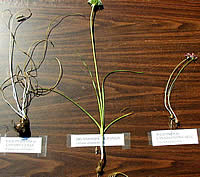
Lily family bulbs such as wild hyacinth (eastern camas), wild onion, and wild garlic, were probably the main plants baked in earth ovens, resulting in the accumulation of burned rock middens across much of northern, central, and eastern Edwards Plateau. The evidence for this comes from charred plant remains found within middens. Photo by Doug Boyd.
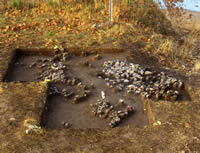
Earth oven facility dating to the 17th century (1600s) at the Honey Creek site in southwestern Mason County. On the right is a mostly intact oven bed (notice the larger rocks) and dark baking pit, while the small scattered rocks to the left are interpreted as clean-out debris from earlier cooking episodes. Although a variety of charred plant remains were found in this area, fragments of two likely baking plants were found � sotol and prickly pear. The absence of any European trade items suggests that this oven was used during the waning years of the prehistoric era. TARL archives.
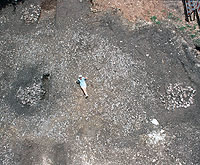
Aerial shot of a plant baking facility or �burned rock midden� that archeologists (aided by heavy equipment) exposed at the Higgins site (41BX184) on the north side of San Antonio. In essence, the midden is donut-shaped with a dark central baking pit, surrounded by a thick ring of small fire-cracked (�burned�) limestone rocks that were pitched out of the pit when the rocks became too small to be useful. Large earth ovens some 5-8 feet across were built over and over again in the central pit (and sometimes elsewhere as well). In fact, the remains of three earth ovens are visible, one in the dark center of the midden, one at the top and one on the far right. TARL archives.
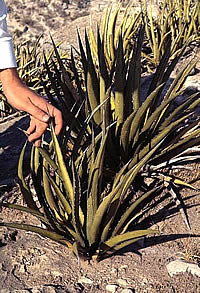
In Lower Pecos Canyonlands and far west Texas, lechuguilla, the smallest species of the agave family, was one of the main plants baked in the earth ovens that resulted in burned rock midden accumulations. The plants shown here are drought stricken and unsuitable for baking. In wet years, lechuguilla plants are greener and filled out; when properly baked for several days, the hearts of the plants are quite sweet and readily digestible. Photo by Phil Dering.




